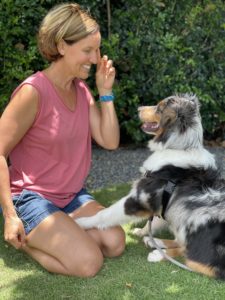A big question I receive is “how do I get my dog to pay attention to me. No matter what.”
I feel the ‘Look’ exercise is underused. If past students tell me their dog is starting to bark on their leash, I’ll remind them to use the ‘Look’ exercise. Here are some other examples of how I use this exercise:
- To redirect your dog from other dogs
- To redirect your dog from cats
- To redirect your dog from something they are afraid of such as skateboards or bicycles
- To stop your dog from pulling
- To stop your dog from smelling
- And so much more!
A word of caution: training a reliable ‘look’ takes time, practice, and patience. You must start this training in a quiet, non-distracting environment. As your dog gets better, you can increase the distractions and your expectations.
Always remember, consistency over time gets results! Take a look how I train the behavior ‘Look’:
![]()
 Purpose for LOOK: Teaching this exercise will train your dog that it is more reinforcing to pay attention to you than the distractions around him.
Purpose for LOOK: Teaching this exercise will train your dog that it is more reinforcing to pay attention to you than the distractions around him.
Criteria: Your dog should look at you.
Hand signal: Point to your eyes.
Verbal cue: ‘Look’
What you will need:
- Treats
- Clicker if you choose to use one
How to train LOOK
Step by Step:
- Start in an area with no distractions.
- Take a treat and slowly wave it in front of your dog’s nose; with your dog watching, bring it to your eyes.
- Say ‘Look’ then ‘ok’ then give your dog the treat.
- The above cues must be given in that order. Your verbal ‘ok’ is their cue that they can look away.
- When beginning this behavior, only expect your dog to look at you for 2 seconds.
- Repeat several times in an environment that is not distracting. Slowly start increasing the length of time your dog looks at you.
- Move to different environments that are not distracting.
- After 50 successful approximations of your dog looking at you while using the food lure, begin to fade the use of the lure.
- Fading the food can be done by asking for ‘Look’ with the treat in your hand near your eyes, but reinforce your dog from the hand that is not near your eye.
- After 10 successful approximations:
- Do not use a food lure. Give both your verbal cue ‘look’ and your visual cue, pointing to your eyes. Reinforce from the hand that is not near your eye.
- After 10 successful approximations:
- Intermittently reinforce your dog. Don’t forget the occasional ‘jackpots’ to encourage your dog to look at you in future exercises.
- Slowly start to add more distractions for your dog.






